Shift Your Habit and Look Beautiful for Less
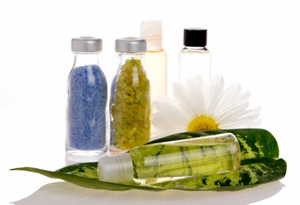
Want to go green, but not ready to give up on beauty products and fashion? Good news: you don't have to. Shift Your Habit author Elizabeth Rogers shares her favorite ways save big and go green fashionably.
This probably won't come as much of a surprise, but when it comes to topics like fashion and beauty, I'm a huge believer in simplicity. Dressing well and maintaining a youthful look should never send us deep into debt. Yet many of us behave as though looking and feeling good require taking an hour each night to douse our faces in a dozen age-defying chemicals, and spending far more than we can afford on clothes and accessories that will be out of style within a year.Deep down, don't we all know that none of this is sustainable—and even more importantly, that it's unlikely to make us happy? These simple shifts are aimed at boosting your radiance and confidence, in the hope that everything else will take care of itself.
Make Your Own Beauty Products
Make beauty products at home from natural ingredients in your cupboards and refrigerator. After all, some people suggest that because you absorb whatever you put on your body, you shouldn't apply anything to your skin that you wouldn't eat.
You'll save $500 a year or more, and save the planet too. How? By sparing the resources used to produce, transport and package skin care products, as well as the waste that is eventually generated when the empty plastic or glass containers are disposed of.
And it's good for you! Most conventional skin care products use chemicals that are potentially harmful to your health. By making your own concoctions from the ingredients you might put in a smoothie, you know you're doing your body good.
Before you try any of these recipes, consider food allergies. Chances are, if it irritates the inside of your body, it will bother the outside as well.
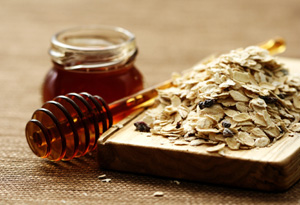
Recipes for Great Skin—Facial Scrub
Your skin is your body's largest organ. And it happens to be very porous. This means that what goes on the outside of your skin is eventually absorbed into your body. Check out these recipes for gorgeous skin and huge savings—up to $350 per year or more, compared to buying equivalent boutique-branded products containing natural or organic ingredients.
Start with your own facial scrub and save $80 a year over a boutique-branded face scrub.
Grind 16 whole unbleached almonds and 4 tablespoons of oats in your blender, food processor or coffee grinder. Don't blitz it for too long—you want bits big enough to slough off rough skin. Then mix the grit with 2 tablespoons of honey and about 4 teaspoons of yogurt or water—enough to create a loose paste.
Gently pat this mixture into a clean face and leave on for 10 minutes. Wet your hands to gently massage it into your skin. Splash your face with tepid water to remove. Use no more than twice per week and remember to follow it up with a moisturizer.
Your skin is your body's largest organ. And it happens to be very porous. This means that what goes on the outside of your skin is eventually absorbed into your body. Check out these recipes for gorgeous skin and huge savings—up to $350 per year or more, compared to buying equivalent boutique-branded products containing natural or organic ingredients.
Start with your own facial scrub and save $80 a year over a boutique-branded face scrub.
Grind 16 whole unbleached almonds and 4 tablespoons of oats in your blender, food processor or coffee grinder. Don't blitz it for too long—you want bits big enough to slough off rough skin. Then mix the grit with 2 tablespoons of honey and about 4 teaspoons of yogurt or water—enough to create a loose paste.
Gently pat this mixture into a clean face and leave on for 10 minutes. Wet your hands to gently massage it into your skin. Splash your face with tepid water to remove. Use no more than twice per week and remember to follow it up with a moisturizer.
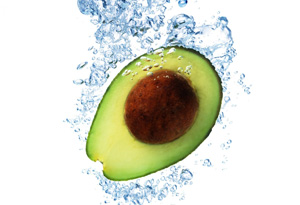
Recipes for Great Skin—Facial Mask
Puree in a blender (or mash and mix in a bowl) one avocado, 2 teaspoons of plain yogurt and 2 teaspoons of honey. Apply this mask to just-washed skin.
These three ingredients work well together. Avocado has healing qualities: It rejuvenates skin, soothes sunburn and delivers a dose of antioxidants. Yogurt relieves sunburn and redness, and its lactic acid helps hydrate and smooth. Honey soothes, heals and nourishes, and some say it has anti-microbial, skin-clearing properties.
This mask can save you $20 or more a year over a commercial organic facial mask.
Puree in a blender (or mash and mix in a bowl) one avocado, 2 teaspoons of plain yogurt and 2 teaspoons of honey. Apply this mask to just-washed skin.
These three ingredients work well together. Avocado has healing qualities: It rejuvenates skin, soothes sunburn and delivers a dose of antioxidants. Yogurt relieves sunburn and redness, and its lactic acid helps hydrate and smooth. Honey soothes, heals and nourishes, and some say it has anti-microbial, skin-clearing properties.
This mask can save you $20 or more a year over a commercial organic facial mask.
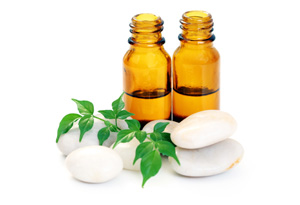
Recipes for Great Skin—Facial Oil
Combine 1 ounce jojoba oil with 1 ounce grapeseed oil. Add one vitamin E capsule, and a few drops of lavender and neroli essential oils. Both grapeseed and jojoba oils are great for troubled skin types—neither will aggravate acne, but both are highly moisturizing. Apply after cleansing to moisturize skin.
You'll save $50 a year, compared to commercial blends made from essential oils.
Combine 1 ounce jojoba oil with 1 ounce grapeseed oil. Add one vitamin E capsule, and a few drops of lavender and neroli essential oils. Both grapeseed and jojoba oils are great for troubled skin types—neither will aggravate acne, but both are highly moisturizing. Apply after cleansing to moisturize skin.
You'll save $50 a year, compared to commercial blends made from essential oils.

Top Swap
Most people wear only about 40 percent of the clothes they own. Americans discard 690,000 tons of clothing a year, which breaks down to about 20 pounds per year for a household of four.
How can you save $100? Instead of hitting the mall, throw a clothing swap party with friends. This saves the planet by conserving the resources and energy used to produce and transport new clothing.
Plus, a clothing swap is a great way to catch up with friends you haven't seen in forever. Anything left over can be donated to charity—and it only seems fair that the organizer gets the deduction! As a bonus, many charities will pick up large donations.
Most people wear only about 40 percent of the clothes they own. Americans discard 690,000 tons of clothing a year, which breaks down to about 20 pounds per year for a household of four.
How can you save $100? Instead of hitting the mall, throw a clothing swap party with friends. This saves the planet by conserving the resources and energy used to produce and transport new clothing.
Plus, a clothing swap is a great way to catch up with friends you haven't seen in forever. Anything left over can be donated to charity—and it only seems fair that the organizer gets the deduction! As a bonus, many charities will pick up large donations.

Take Care
Extend the lifetime of the items in your wardrobe by making an effort to care for them properly. If this helps you spend $50 less a month on clothes, you could save up to $600 a year. This will save the planet by conserving the natural resources, energy and chemical dyes required to manufacture new garments, and it also will keep old clothes from piling up at the landfill.
Unlike clothes that go "out of style"—which, of course, is subjective—stained, ripped or worn-out clothes are much less likely to be selected by a thrift store shopper. Fashion editors have been using this trick for years: If you make a habit of buying new clothes seasonally, limit yourself to just one trendy item and make all your other purchases the highest-quality basics you can afford. True style is not disposable.
Use these 7 tips to give your wardrobe a long, happy—and green—life:
Extend the lifetime of the items in your wardrobe by making an effort to care for them properly. If this helps you spend $50 less a month on clothes, you could save up to $600 a year. This will save the planet by conserving the natural resources, energy and chemical dyes required to manufacture new garments, and it also will keep old clothes from piling up at the landfill.
Unlike clothes that go "out of style"—which, of course, is subjective—stained, ripped or worn-out clothes are much less likely to be selected by a thrift store shopper. Fashion editors have been using this trick for years: If you make a habit of buying new clothes seasonally, limit yourself to just one trendy item and make all your other purchases the highest-quality basics you can afford. True style is not disposable.
Use these 7 tips to give your wardrobe a long, happy—and green—life:
- Wash like colors together.
- Read the fabric care label before cleaning to prevent garment from shrinking, wrinkling or being otherwise ruined.
- Hand-wash and line-dry.
- Treat stains immediately.
- Change out of work clothes when you get home to prevent unnecessary wear-and-tear and stains during dinner preparation, housework and baby duty.
- Don't wear clothes you'd go out in to do chores, outdoor work or activities in which you might get dirty or sweaty.
- Keep earrings, bracelets, necklaces, rings and other jewelry in an organized container to prevent them from getting lost, broken, eaten by a pet or sucked up by the vacuum.

Unstain
Americans throw away 1.4 billion pounds of shoes and clothing every year! If we all did a little more stain treating, this number could plummet.
For starters, treat the stain as soon as possible to prevent it from setting. And don't put a stained garment in the dryer until you've treated the stain. The dryer's heat will cause the stain to set.
How do you get rid of stubborn stains? Try these remedies:
Americans throw away 1.4 billion pounds of shoes and clothing every year! If we all did a little more stain treating, this number could plummet.
For starters, treat the stain as soon as possible to prevent it from setting. And don't put a stained garment in the dryer until you've treated the stain. The dryer's heat will cause the stain to set.
How do you get rid of stubborn stains? Try these remedies:
- Berries, Fruit and Juice
Pour boiling water on the stain. Pre-treat if necessary and wash as usual. - Grease, Oil and Butter
Pour cornmeal or flour on the stain and let it sit and absorb the oil. Pretreat and wash as usual. - Dirt and Mud
Rub the cut end of a potato on the stain and let it set for a few hours before washing as usual. - Grass Stains
Rub out with white vinegar. Wash as usual. - Wine
Soak in milk overnight, or rub on white toothpaste. Then wash as usual.
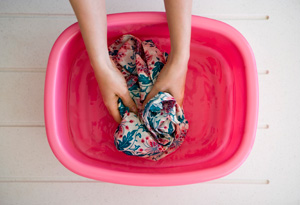
Dry Clean (Not) Only
Some clothing labeled "dry clean only" actually can be hand-washed in cold water and hung to dry without any damage being done to the garment. This includes sweaters (yes, even cashmere), rayon, silk and some wool. If you normally dry clean a garment once a month, this can save you $150 a year.
This is a great way to save the planet. Perchloroethylene—or perc—the chemical used in most dry cleaning operations, is listed by the EPA as a hazardous substance to both human health and the environment. Long-term exposure to perc can cause liver and kidney damage and is classified as a possible carcinogen.
Professional cleaning is recommended for angora, fabrics with fancy stitching or embroidery, and structured or lined garments. After you pick these items up at the cleaners, remove the plastic covering protecting them and let them air out for five days or more before wearing them.
Some clothing labeled "dry clean only" actually can be hand-washed in cold water and hung to dry without any damage being done to the garment. This includes sweaters (yes, even cashmere), rayon, silk and some wool. If you normally dry clean a garment once a month, this can save you $150 a year.
This is a great way to save the planet. Perchloroethylene—or perc—the chemical used in most dry cleaning operations, is listed by the EPA as a hazardous substance to both human health and the environment. Long-term exposure to perc can cause liver and kidney damage and is classified as a possible carcinogen.
Professional cleaning is recommended for angora, fabrics with fancy stitching or embroidery, and structured or lined garments. After you pick these items up at the cleaners, remove the plastic covering protecting them and let them air out for five days or more before wearing them.

Can a Dry Cleaner Be Green?
Over the past few years, there's been a boom in "natural," "green" and "organic" dry cleaning businesses. While many of them operate in a more environmentally sensitive way than traditional establishments, there's no system of regulation or certification that guarantees they avoid toxic chemicals. If you're considering switching to a greener cleaner, ask the owner about the active ingredients they use to clean your clothes.
The best methods are "wet cleaning," silicone-based cleaning and carbon dioxide (CO2) cleaning. If they still employ perc, don't waste your money by paying more for their services. Regardless of which dry cleaning method you choose, it's in your best interest to employ it as infrequently as possible.
Here are 6 practical ways to limit your need to dry clean clothes:
Elizabeth Rogers is the co-author of The Green Book. Her latest book, Shift Your Habit, is about a new way of thinking that leads to both saving money and living consciously.
Keep Reading:
No more hemp sacks! 4 designers with a green conscience
When New York's Fashion Week went eco-friendly
10 things you can do to go green this weekend
Over the past few years, there's been a boom in "natural," "green" and "organic" dry cleaning businesses. While many of them operate in a more environmentally sensitive way than traditional establishments, there's no system of regulation or certification that guarantees they avoid toxic chemicals. If you're considering switching to a greener cleaner, ask the owner about the active ingredients they use to clean your clothes.
The best methods are "wet cleaning," silicone-based cleaning and carbon dioxide (CO2) cleaning. If they still employ perc, don't waste your money by paying more for their services. Regardless of which dry cleaning method you choose, it's in your best interest to employ it as infrequently as possible.
Here are 6 practical ways to limit your need to dry clean clothes:
- Wear an undershirt to keep sweat and odor from soiling your shirts and jackets.
- Get stains out as soon as they happen—don't wait until they're dried up and baked in.
- Hang clothes as soon as you take them off to prevent them from getting wrinkled, walked on or soiled on the floor.
- Use a garment steamer to freshen clothes instead of cleaning them.
- Toss items in the dryer for 10 minutes with a damp washcloth to steam them.
- Use a lint brush to remove dust, dirt or dander that may settle in over time.
Elizabeth Rogers is the co-author of The Green Book. Her latest book, Shift Your Habit, is about a new way of thinking that leads to both saving money and living consciously.
Keep Reading:
No more hemp sacks! 4 designers with a green conscience
When New York's Fashion Week went eco-friendly
10 things you can do to go green this weekend



